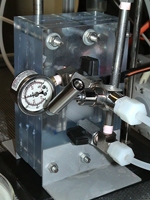 A
significant hurdle to the implementation of a
hydrogen-based economy is the fact that hydrogen cannot be
made at an economically feasible price. It is widely
speculated that water electrolysis, which separates water
into its component elements of hydrogen and oxygen, will
be the means of generating hydrogen in this type of
economy. Water electrolysis systems (electrolyzers)
currently employ either platinum or nickel-based alloy
electrodes, which can account for up to 80% of the cost of
a commercial electrolyzer. Based on an analysis of the
Photosystem II process, which is widely observed in
nature, thin metal oxide films have been developed in the
laboratory at FSU for the purpose of improving water
electrolysis. These films have demonstrated the ability to
generate both hydrogen and oxygen near their thermodynamic
limits, thus allowing for efficiencies above 99%.
A
significant hurdle to the implementation of a
hydrogen-based economy is the fact that hydrogen cannot be
made at an economically feasible price. It is widely
speculated that water electrolysis, which separates water
into its component elements of hydrogen and oxygen, will
be the means of generating hydrogen in this type of
economy. Water electrolysis systems (electrolyzers)
currently employ either platinum or nickel-based alloy
electrodes, which can account for up to 80% of the cost of
a commercial electrolyzer. Based on an analysis of the
Photosystem II process, which is widely observed in
nature, thin metal oxide films have been developed in the
laboratory at FSU for the purpose of improving water
electrolysis. These films have demonstrated the ability to
generate both hydrogen and oxygen near their thermodynamic
limits, thus allowing for efficiencies above 99%.